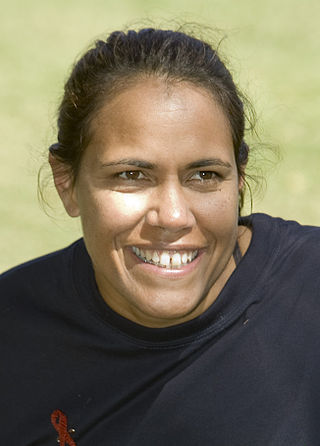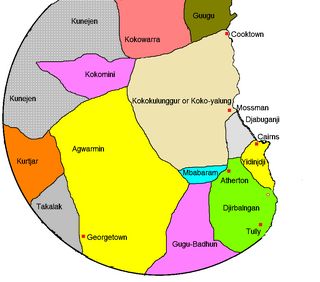Related Research Articles
Guugu Yimithirr, also rendered Guugu Yimidhirr, Guguyimidjir, and many other spellings, is an Australian Aboriginal language, the traditional language of the Guugu Yimithirr people of Far North Queensland. It belongs to the Pama-Nyungan language family. Most of the speakers today live at the community of Hope Vale, about 46 kilometres (29 mi) from Cooktown. However, as of June 2020 only about half of the Guugu Yimithirr nation speak the language. As such, efforts are being made to teach it to children. Guugu Yimithirr is the source language of the word kangaroo.
Mbabaram (Barbaram) is an extinct Australian Aboriginal language of north Queensland. It was the traditional language of the Mbabaram people. Known speakers were Albert Bennett, Alick Chalk, Jimmy Taylor and Mick Burns. Recordings of Bennett and Chalk are held in the Audiovisual Archive of the Australian Institute of Aboriginal and Torres Strait Islander Studies. R. M. W. Dixon described his hunt for a native speaker of Mbabaram in his book Searching for Aboriginal Languages: Memoirs of a Field Worker. Most of what is known of the language is from Dixon's field research with Bennett.

Daintree is a rural town and locality in the Shire of Douglas, Queensland, Australia. In the 2016 census, Daintree had a population of 129 people.
Kuku-Thaypan is an extinct Paman language spoken on the southwestern part of the Cape York Peninsula, Queensland in Australia, by the Kuku-Thaypan people. The language was sometimes called Alaya or Awu Alaya. Koko-Rarmul may have been a dialect, though Bowern (2012) lists Gugu-Rarmul and Kuku-Thaypan as separate languages. The last native speaker, Tommy George, died on 29 July 2016 in Cooktown Hospital.

The Kuku Yalanji, also known as Gugu-Yalanji, Kuku Yalandji or Kokojelandji, are an Aboriginal Australian people originating from the rainforest regions of Far North Queensland.
Wambaya is a Non-Pama-Nyungan West Barkly Australian language of the Mirndi language group that is spoken in the Barkly Tableland of the Northern Territory, Australia. Wambaya and the other members of the West Barkly languages are somewhat unusual in that they are suffixing languages, unlike most Non-Pama-Nyungan languages which are prefixing.

The Paman languages are an Australian language family spoken on Cape York Peninsula, Queensland. First noted by Kenneth Hale, Paman is noteworthy for the profound phonological changes which have affected some of its descendants.

The Shire of Cook is a local government area in Far North Queensland, Australia. The Shire covers most of the eastern and central parts of Cape York Peninsula, the most northerly section of the Australian mainland.

The Bloomfield River is a river in the Wet Tropics of Far North Queensland, Australia, noted for its Bloomfield River cod fish species, found only in the river.
Bidjara, also spelt Bidyara or Pitjara, is an Australian Aboriginal language. In 1980, it was spoken by 20 elders in Queensland between the towns of Tambo and Augathella, or the Warrego and Langlo Rivers. There are many dialects of the language, including Gayiri and Gunggari. Some of them are being revitalised and are being taught in local schools in the region. The various dialects are not all confirmed or agreed by linguists.
The Kuku Nyungkal dialect is an Australian Aboriginal language and the language of the Kuku Nyungkal people of Far North Queensland. It is a variety of Kuku Yalanji still being spoken. Most of the speakers today live in the communities of Wujal Wujal and Mossman.

The Wujal Wujal Aboriginal Shire is a local government area in Far North Queensland, Australia. It is managed as a Deed of Grant in Trust under the Local Government Act 2004.
Mbariman-Gudhinma, one of several languages labelled Gugu Warra 'unintelligible speech' as opposed to Gugu Mini 'intelligible speech', is an extinct dialect cluster of Aboriginal Australian languages of the Cape York Peninsula in northern Queensland, Australia. Another one in the group is Wurangung, also known as Yadaneru or Jeteneru.

Wamin, also known as Agwamin or Ewamian, is an Australian Aboriginal language of North Queensland spoken by the Ewamian people. Wamin was traditionally spoken in the Etheridge region, in the areas around Einasliegh, Georgetown, and Mount Surprise.
Wagaman or Wakaman is the name of several languages in Queensland, Australia. It may refer to:

Palmer is a rural locality in the Shire of Cook, Queensland, Australia. In the 2021 census, Palmer had a population of 46 people.

The Mossman River is a river in the Cape York Peninsula of Far North Queensland, Australia.
The Wakaman people, also spelt Wagaman, are an Aboriginal Australian people of the state of Queensland. According to some authorities, they may be interchangeable with the group identified by ethnographers as the Agwamin.
The Ewamian or Agwamin people are an Aboriginal Australian people of the state of Queensland.
Mount Mulgrave is a rural locality in the Shire of Mareeba, Queensland, Australia. In the 2016 census, Mount Mulgrave had a population of 0 people.
References
- ↑ Y108 Wagaman at the Australian Indigenous Languages Database, Australian Institute of Aboriginal and Torres Strait Islander Studies
- ↑ Y132 Agwamin at the Australian Indigenous Languages Database, Australian Institute of Aboriginal and Torres Strait Islander Studies
- ↑ Y132.1 Wamin at the Australian Indigenous Languages Database, Australian Institute of Aboriginal and Torres Strait Islander Studies
- ↑ Y233 Wakaman at the Australian Indigenous Languages Database, Australian Institute of Aboriginal and Torres Strait Islander Studies
- ↑ "SBS Australian Census Explorer" . Retrieved 10 January 2023.
- ↑ Dixon, RMW (2002). Australian Languages: Their Nature and Development. Cambridge: Cambridge University Press. pp. xxxii.
- ↑ Y78 Guugu Yalandji at the Australian Indigenous Languages Database, Australian Institute of Aboriginal and Torres Strait Islander Studies
- ↑ Endangered Languages Project data for Djangun.
- ↑ Endangered Languages Project data for Muluridyi.
- 1 2 Patz, Elisabeth (2002). A Grammar of the Kuku Yalanji Language of North Queensland (PDF). Pacific Linguistics 527. Canberra: Pacific Linguistics. doi: 10.15144/pl-527 . hdl: 1885/146148 . ISBN 978-0-85883-534-4.